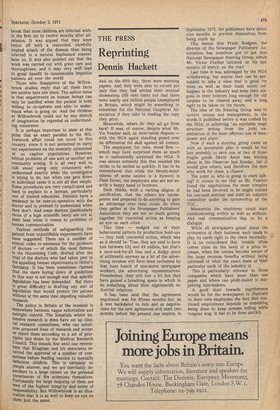The Wi1lowbroo1 experiment
John Rowan Wilson
Willowbrook is a large residential schoa on Staten Ireland in New York housing 9 population of 5,000 mentally defective children. Over the last fifteen years some of these children, have been the subject of a mass experiment with unique implica. tions. It is not only of great medical im. portance, it also raises in a dramatic formi the ethical problems in carrying out scientific investigations on human beings.
The original object of the Willowbrook experiment was the study of infectious hepatitis, in the hope of finding a means of protection against the disease. Hepatitis, is a virus disease which does not respond to antibiotics. It is disabling and unpleas. ant while the infection lasts, and in a small minority of cases may also lead to corn. plications in the shape of chronic liver dis. ease. To develop a vaccine against it is one of the highest priorities in current medical research.
One of the difficulties in developing a vaccine has been a lack of understanding of the nature of the virus strains involved. For many years there has been a sus. picion that what we call infectious hepa' titis is really two distinct diseases, caused by different viruses, but until recently no. body could confirm this in the laboratory. Dr Saul Krugman, a professor of paediat. rics at the New York School of Medicine, decided that the only way in which the problem could be solved was by causing arl infection under controlled conditions: that is to say, by administering the virus to children. The procedure was started at Wil' lowbrook in 1956. Since then, hepatitis has been artificially produced in several hun' dred mentally defective children. There is no doubt that the experiment has been, scientifically speaking, success' ful. It has helped to establish beyond doubt that there are two forms of the disease and may well lead to the development d an effective vaccine. The work has through' out received support and encouragement from the American scientific Establish' ment. It has been backed by all kinds of official boards and committees, It has been published in such highly respected journals, as the Journal of the American Medial,' Association, the New England Journal of Medicine, and the Journal of Infectious Diseases. Indeed, it attracted surprisinglY little attention until recently. It was onlY when a letter from Dr Stephen Goldby NO published in the Lancet that the contro' versy erupted. The question Dr Goldby raised was lid; whether the experiment was well done bt1,1 whether it should have been done at al' The justification given by the authors, t° put it in its simplest form, was that the children concerned would almost certainlY have contracted hepatitis anyway. Tile, virus is evidently so prevalent in Willovw brook that most children are infected within the first six to twelve months after admission. It was argued that they were better off with a controlled, carefully treated attack of the disease than being infected in a natural haphazard manner later on. It was also pointed out that the work was carried out with great care and thoroughness, and it may very well lead to great benefit to innumerable hepatitis patients all over the world.
Those who disapprove of the Willowbrook studies reply that all these facts are neither here nor there. The salient issue is that experiments on human beings can only be justified when the patient is both Willing to co-operate and able to understand what is going on. And the children at Willowbrook could not by any stretch of imagination be regarded as understanding volunteers.
It is perhaps important to state at this Point that an exact parallel to the Willowbrook affair could not occur in this country, since it is not permitted to carry out experiments on the mentally subnormal or on captive populations. However, ethical problems of one sort or another are constantly arising. It is all very well to talk about using only volunteers who understand exactly what the investigator Is trying to do, but when one gets down to individual cases it is not all that simple. Some procedures are very complicated and hard to explain to a layman, particularly one of limited education. Patients have a tendency to be over-co-operative with the doctor and to pretend to understand when they don't. And some doctors (particularly those of a high scientific bent) are not at their best when it comes to problems of human communication.
Various methods of safeguarding the Patient from unjustifiable experiments have been suggested. There are a number of ethical codes in existence for the guidance of doctors — of which the most famous IS the Nuremberg Code, drafted after the trial of the doctors who had taken part in the appalling human experiments in Hitler's Germany. It has been sometimes claimed that the mere laying down of guidelines in this way is not enough and that spacific legislation has been demanded. But there is great difficulty in drafting any sort of legislation that would protect the patient Without at the same time impeding valuable research.
The policy in Britain at the moment is somewhere between vague exhortation and outright control. The hospitals where extensive research is done have set up clinical research committees, who can scrutinize proposed lines of research and accept or reject them according to a set of principles laid down by the Medical Research Council. This sounds fine until one remembers that Krugman and his associates received the approval of a number of committees before feeding vaccine to mentally defective children. This is certainly no simple answer, and we are inevitably dependent to a large extent on the personal consciences of the scientists themselves. Fortunately the large majority of them are men of the highest integrity and sense of responsibility. But Willowbrook is an illustration that it is as well to keep an eye on them just the same.

































 Previous page
Previous page